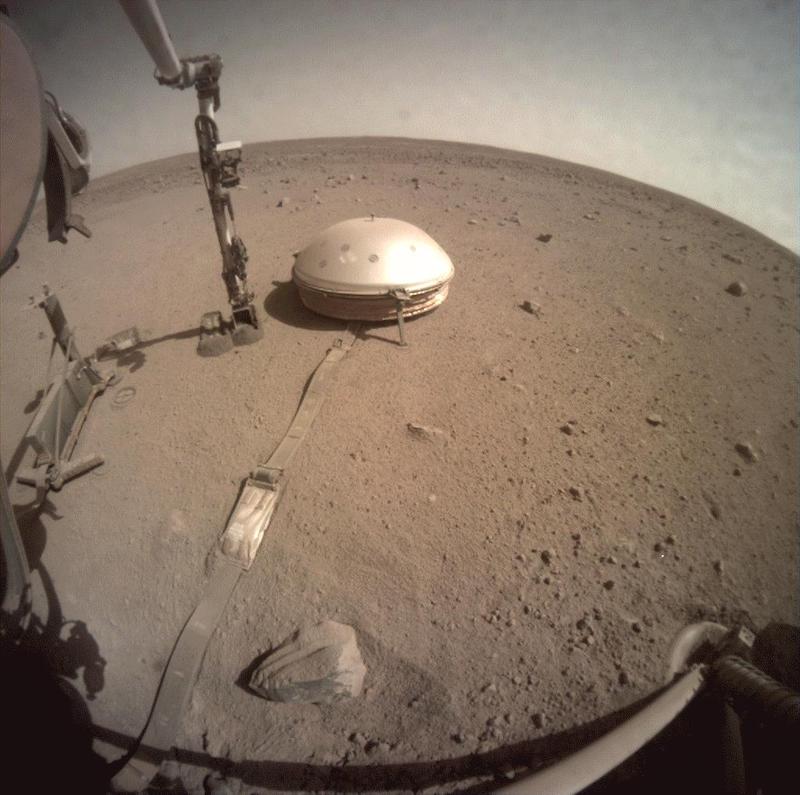Mars is shaking! An international team of researchers provided an update on December 14, 2022, on the many marsquakes that NASA’s InSight lander has recorded. The scientists pointed to the largest marsquake detected so far, a magnitude 4.7 quake some five times larger than the previous record-holder. It happened on on May 4, 2022. It’s puny by earthly standards (although large enough to be felt by someone standing above it). But it’s the biggest by far of the thousands of marsquakes to date.
And it’s evidence that Mars isn’t entirely geologically dead!
Researchers presented details about the largest marsquake last week at the December 12 to 16 meeting of the American Geophysical Union, in Chicago. They also published their peer-reviewed findings in three new papers in Geophysical Research Letters on December 14. The first paper is an overview of the InSight findings, the second focuses on the surface waves generated by the marsquake and the third deals with the surface waves’ velocities.
The Mars Seismic Experiment for Interior Structure (SEIS) data service, NASA Planetary Data System (PDS) and the Incorporated Research Institutions for Seismology (IRIS) and the MQS catalog released the data from this marsquake in early October. InSight uses its SEIS instrument to monitor for marsquakes.
Biggest marsquake detected so far
As lead author Taichi Kawamura at the Institut de physique du globe de Paris, France, said:
[The May 4, 2022 quake] was definitely the biggest marsquake that we have seen.
Co-author and seismologist John Clinton at the Swiss Seismological Service, ETH Zurich, added:
The energy released by this single marsquake is equivalent to the cumulative energy from all other marsquakes we’ve seen so far. And although the event was over 2,000 kilometers (1,200 miles) distant, the waves recorded at InSight were so large they almost saturated our seismometer.
5 times stronger than previous largest marsquake
This marsquake, at magnitude 4.7, was five times stronger than the previous largest known. That one, recorded in August 2021, registered at magnitude 4.2. The paper states:
After three years of seismic monitoring of Mars by InSight SEIS instrument, we detected a marsquake largest ever observed during the mission. The event is larger by factor of five in seismic moment compared to previously detected events. With such an energetic event, we discovered various seismic features that was never observed before. For the first time, we were able to detect body waves and surface waves with their overtones. The large variety of detected seismic phases will enable us to probe the internal structure of Mars.
Clues about Mars’ interior structure
Measuring marsquakes also provides clues about the interior of Mars. Scientists can study the surface waves produced in the seismic events. By doing so, they learn more about what Mars is like underground. This is the first time that researchers have been able to track such surface waves. Clinton said:
For the first time we were able to identify surface waves, moving along the crust and upper mantle, that have traveled around the planet multiple times.
For this largest marsquake, the surface waves lasted for more than 10 hours. All previous marsquakes lasted for less than an hour.
Cerberus Fossae, within Elysium Planitia (where InSight landed), is the most seismically active known region on Mars. Interestingly, the epicenter of this largest marsquake lies just outside of Cerberus Fossae, but not within it. The researchers couldn’t specifically connect the marsquake to any known geologic feature. There may, however, be a related feature deeper down.
The paper says:
Secondly, the event was located outside a well-known seismically active region of Cerberus Fossae. This might indicate that that event do not come from the same fault system with other major marsquakes.
As EarthSky also reported recently, there is evidence of a massive mantle plume of hot lava below the Elysium Planitia region. Researchers now believe that this mantle plume drives much of the seismic activity, the marsquakes, detected by InSight.
Different kinds of marsquakes
Basically, there are two types of marsquakes. Some have high-frequency waves characterized by rapid but shorter vibrations. Others are low-frequency, when the surface moves slowly but with larger amplitude. This largest marsquake, curiously, had characteristics of both types. That is a rare event on Mars. The researchers say this might mean that both types of marsquakes might actually be different aspects of the same geological process(es). The researchers need to do more work, however, to determine if that is really the case, however.
The marsquakes show that Mars is still geologically active below the surface. Until now, most scientists thought that the planet was pretty much dead.
Last September, mission scientists also reported that InSight detected the vibrations from four meteoroid impacts.
Rather than dead, it seems that Mars is still very much geologically alive. With further research, we should learn much more about just how active Mars really is. As Kawamura said:
Stay tuned for more exciting stuff following this.
Bottom line: Researchers released new details about the largest marsquake recorded so far. At magnitude 4.7, it was five times stronger than the previous largest known quake.
Source: S1222a – the largest Marsquake detected by InSight
Source: Crustal Anisotropy in the Martian Lowlands From Surface Waves

